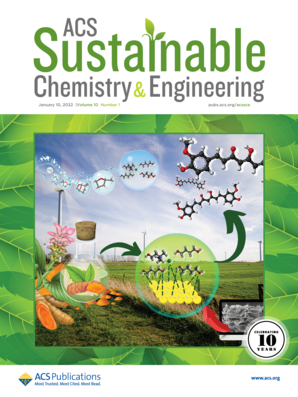水不溶性C-Only塑料废弃物的高效电化学重整
IF 7.1
1区 化学
Q1 CHEMISTRY, MULTIDISCIPLINARY
引用次数: 0
摘要
本文报道了在3v的水溶液中,对仅由C-C和C-H键组成的碳氢化合物聚合物废弃物进行高效的电化学重整。在Ni/ sb掺杂的SnO2电极上,这些化学弹性废物的阳极降解达到了32%的法拉第效率。疏水塑料颗粒最初以大聚集体的形式存在,在反应的早期阶段被溶解,这是实现高重整效率所必需的。阴极制氢的法拉第效率和能源效率分别高达57%和30%。在优化的条件下,电重整需要约0.10 kWh/g塑料降解,这比之前报道的掺硼金刚石阳极效率高120倍。如果扩大规模,可以实现低至2000美元/吨的能源成本,而产生的氢气可以覆盖这些成本的70%左右。二氧化碳排放量预计在1.65至13.02 kgCO2eq/kgH2之间,与传统的塑料制氢高温工艺相比具有竞争力。我们的研究结果支持塑料电重整的工业潜力,以有效地处理化学弹性塑料废物。本文章由计算机程序翻译,如有差异,请以英文原文为准。

Efficient Electrochemical Reforming of Water-Insoluble C-Only Plastic Wastes
We report here the efficient electrochemical reforming of hydrocarbon polymer wastes, i.e. composed of C–C and C–H bonds only, in aqueous solution at 3 V. Anodic degradation of these chemically resilient wastes is achieved with Faradaic efficiencies of up to 32% on a Ni/Sb-doped SnO2 electrode. The hydrophobic plastic particles, initially present as large aggregates, are solubilized during the early stages of the reaction, which is essential to achieve high reforming efficiencies. Cathodic H2 generation is demonstrated with Faradaic and energy efficiencies of up to 57% and 30%, respectively. Under optimized conditions, electroreforming requires ca. 0.10 kWh/g of plastic degraded, which is >120 times more efficient than that previously reported on boron-doped diamond anodes. If scaled up, energy costs as low as ca. 2000$/ton could be achieved, while the H2 generated could cover up to ca. 70% of these costs. CO2 emissions, expected to be ranging from 1.65 to 13.02 kgCO2eq/kgH2, are competitive with conventional plastic-to-H2 high-temperature processes. Our results support the industrial potential of plastic electroreforming to efficiently treat chemically resilient plastic wastes.
求助全文
通过发布文献求助,成功后即可免费获取论文全文。
去求助
来源期刊

ACS Sustainable Chemistry & Engineering
CHEMISTRY, MULTIDISCIPLINARY-ENGINEERING, CHEMICAL
CiteScore
13.80
自引率
4.80%
发文量
1470
审稿时长
1.7 months
期刊介绍:
ACS Sustainable Chemistry & Engineering is a prestigious weekly peer-reviewed scientific journal published by the American Chemical Society. Dedicated to advancing the principles of green chemistry and green engineering, it covers a wide array of research topics including green chemistry, green engineering, biomass, alternative energy, and life cycle assessment.
The journal welcomes submissions in various formats, including Letters, Articles, Features, and Perspectives (Reviews), that address the challenges of sustainability in the chemical enterprise and contribute to the advancement of sustainable practices. Join us in shaping the future of sustainable chemistry and engineering.
 求助内容:
求助内容: 应助结果提醒方式:
应助结果提醒方式:


